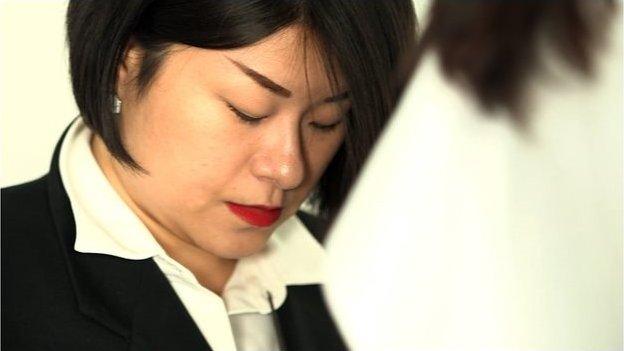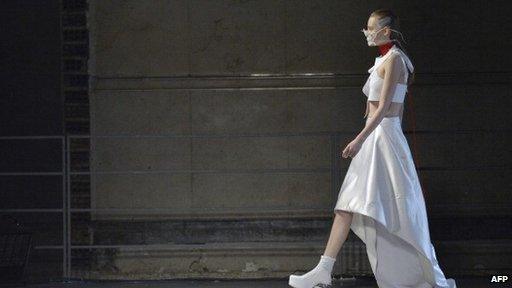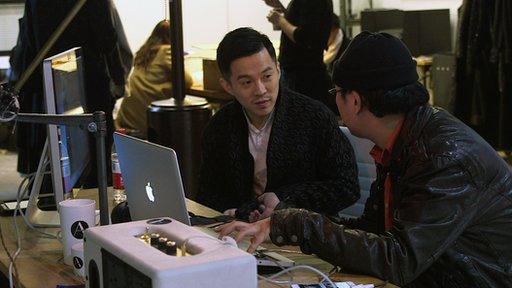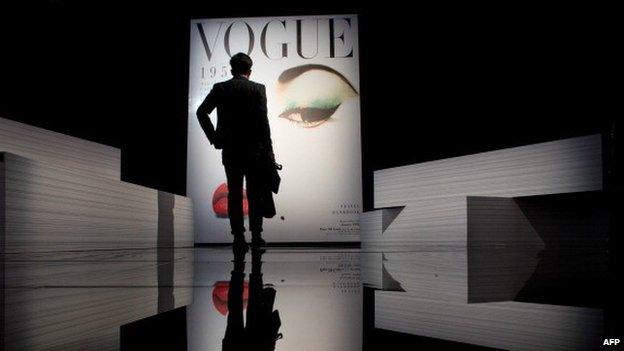Fashion wars: China takes on the West
- Published
Can China build a fashion industry of its own to rival that of the West?
It's mid-February and Chinese designer Masha Ma is in a hurry. She's rushing to get ready for a show at Paris Fashion Week in March.
"My biggest challenge is always time," she says. And fashion is one industry where time really is money.
Ms Ma says her business development colleagues tell her that if one of her new stores does not launch on time, "it's like throwing an iPhone 6 into the river for every hour that it's not open."
Masha Ma is one of a new wave of fashion designers to emerge from China in recent years. They are part of a wider movement that is challenging the notion that the country is better at making things than inventing them.

Chinese designer Masha Ma was born in Beijing but studied at Central Saint Martins in London
"For many generations we Chinese were not encouraged to think creatively," says Angelica Cheung, editor-in-chief of Vogue China, "so there's a certain element of truth to say that the Chinese were not great designers."
But Ms Cheung believes that the situation is changing fast. Just as Chinese artists are growing in confidence, she sees the same thing happening in other creative fields, such as fashion.
"This generation of designers, they were educated in China and they were educated in the West, so they understand both ways of thinking," she adds.
"So they start to have ideas - and the Chinese learn very quickly."
Masha Ma is typical of this new breed. She was born in Beijing and studied at Central Saint Martins in London.
For her, fashion in China has nothing at all to do with out-of-date stereotypes.
"When I was born… there was no dragon or phoenix carpet anywhere. It was after the Cultural Revolution and everybody dressed all the same, regardless of social status," she recalls.

Designer Alexander McQueen's theatrical fashion shows inspired Masha Ma
Growing up, she says she spent a lot of time with her grandmother, who was a strong influence on her. Her grandmother was an actress, and although not famous, Ms Ma remembers that she lived a "very delicate, sophisticated, bourgeois kind of lifestyle, which was really not common at that time in China".
Ms Ma took up art, but became inspired to move into fashion when she saw a magazine article about the designer Alexander McQueen, whom she later ended up working with.
"I was shocked and enlightened. I [couldn't] believe fashion could be done in that sort of way. It was so artistic, it was absolutely out of the context of what fashion was in China," she remembers.
She says she became drawn towards fashion because of the role it can play in people's lives.
"Artists are very selfish in a way," she says. "It's more about expressing their own point of view - designers are more keen to use what they've learned and make our lives better."

Masha Ma says it's important that the silhouette of the design is very simple
For Masha Ma, there are several elements that are important to developing a style that will succeed not only in China, but also beyond.
One is colour. "The palette has to be very civilised. I don't mean to be subtle - it could be red, it could be green - but it needs to be a tasteful," she says.
Another is the silhouette of the design, which has to be very simple - although that is not always an easy thing to achieve.
The third is much harder both to define and to acquire. Ms Ma says it has to do with an element of an almost religious experience, or a sense of holiness. She feels that this is something that Chinese culture can help with.
"It's what will differentiate you from a good designer and a master," she says.

Simon Gao travels frequently, which helps inspire his designs
Other designers agree that a lot of time, effort and experience is needed to develop a style that can make headway on a global stage.
Simon Gao is another Chinese designer who argues that success hinges on developing a more international style. He travels frequently, trying to experience as many different cultures as possible. He says the results can be seen in his work: "My collections are all about that."
But after developing a distinctive voice, what next?
Mr Gao says he is already making progress with the business side of work, which he says is starting to make a profit.

Demand in China for fashion magazine Vogue has grown rapidly over the past decade
Masha Ma says her goal is to go beyond being a designer, and to become "a brand". She recognises that this is not an easy thing to do - nevertheless, she has big plans for the future. She has already opened some stores in China, and plans to build a sizeable chain across the country. She also already has an operation in Paris, and hopes to expand further into the international market in the future.
But how realistic are the dreams of this new band of Chinese designers?
Ms Cheung of Vogue China worries that, in some cases, the business challenges may be more difficult to master than ones related to design. Just because someone is a talented designer, does not mean they will be as skilful at running a business.



But Ms Cheung also points out that the industry in China has come a long way in a fairly short space of time. Her own magazine has grown rapidly in the past 10 years, in response to rocketing demand. Chinese designers can also now be found at the top of some Western brands.
Ms Cheung adds that the speed of change in China has caught some big Western firms on the hop. Around 10 years ago, when interest in fashion was just beginning, much of the focus was on high-end luxury brands. But the market is changing, with growing interest in independent labels.
"There's still a certain gap between what people perceive as the Chinese market and what the Chinese market is really like," she says. The key to success is how quickly you can react.